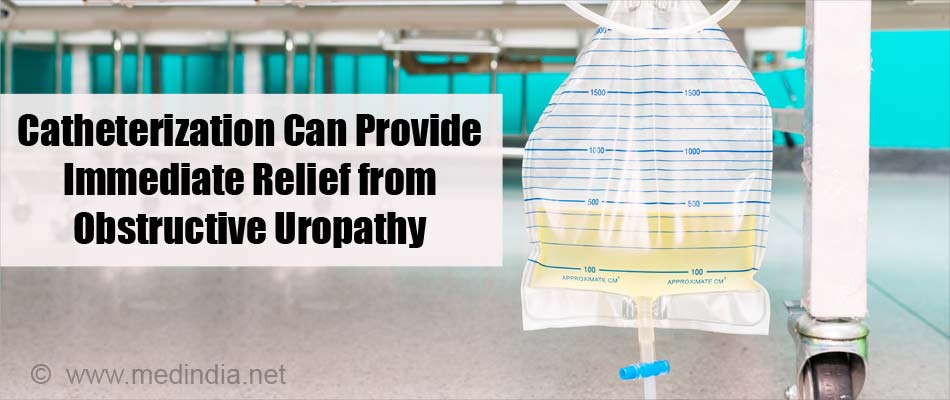- Obstructive uropathy - (https://medlineplus.gov/ency/article/000507.htm)
- Acute bilateral obstructive uropathy - (https://ufhealth.org/acute-bilateral-obstructive-uropathy)
- Obstructive uropathy - (https://radiopaedia.org/articles/obstructive-uropathy)
- Tseng TY, Stoller ML. Obstructive uropathy. Clin Geriatr Med. 2009; 25(3): 437-43. doi: 10.1016/j.cger.2009.06.003
- Macey MR, Raynor MC. Medical and surgical treatment modalities for lower urinary tract symptoms in the male patient secondary to benign prostatic hyperplasia: a review. Semin Intervent Radiol. 2016; 33(3): 217-23. doi: 10.1055/s-0036-1586142
What is Obstructive Uropathy?
- Obstructive uropathy is a condition when the passage of urine from the kidneys to the exterior is blocked by an obstruction anywhere along the urinary tract.
- The obstruction may be at any level including the kidneys, ureters, urinary bladder or the urethra. As a result, there is a back-flow of urine into the kidney, which is technically termed as vesicoureteric reflux (VUR). This back-flow causes swelling of the kidneys and the condition is termed hydronephrosis.
- Obstructive uropathy can be of rapid onset or occur gradually over a long period and can affect one or both kidneys.
- The obstruction may be due to causes intrinsic to the urinary tract or extrinsic causes such as tumors or enlarged lymph nodes compressing the urinary passage externally.
- The incidence varies from 5 in 1000 to 5 in 10,000.
- It is most commonly encountered in men over 60 years due to prostatic enlargement (benign prostatic hyperplasia). In young children, the most common reason is due to birth defects in the urinary tract. In young adults, urinary tract stone is one of the most common causes of obstructive uropathy.
Anatomy & Physiology of the Excretory System in Brief
The kidneys are the primary functional organs of the excretory system. The kidneys are a pair of bean-shaped organs about the size of an adult fist. They are covered by a renal capsule that consists of tough fibrous connective tissue. On top of this are two layers of fat. The external structures of the kidneys include the renal artery which carries oxygenated blood from the heart to the kidneys via the aorta. The renal vein carries deoxygenated blood from the kidneys to the heart via the inferior vena cava.
The kidneys act as natural filters that remove excretory products from the blood. These excretory products pass out as urine and travel down tubes known as ureters that connect the kidneys to the urinary bladder. The bladder stores the urine until it is released to the outside by a process called micturition, which is commonly known as urination.
What are the Causes of Obstructive Uropathy?
Obstructive uropathy can have several causes. The common ones are listed below:
- Kidney stones (nephrolithiasis)
- Congenital anomalies of the urinary tract e.g. posterior urethral valves in children
Prostate enlargement (benign prostatic hyperplasia or BPH) in adults- Urinary bladder stone formation in any age group
- Urethral stricture or stenosis of the urethral opening (meatus)
- Nervous system disorders – spinal injury and multiple sclerosis
- Cancer of the ureter or urinary bladder
- External compression of the urinary tract-
- Chronic constipation with fecal impaction compressing
- Colon cancer
- Uterine cancer
- Cervical cancer
- Pelvic fracture causing injury to the urethra
- Projection of lower end of ureter into the urinary bladder causing obstruction - called (ureterocele)
- Regular use of Drugs such as – anticholinergics, narcotics, and α-receptor agonists
Other common causes of obstruction include formation of strictures i.e. narrowing of the ureter or urethra due to scar tissue formation after radiation therapy carried out on the urinary tract or adjoining organs such as for cervix for cancer.
Ligating the ureter can happen inadvertently during surgeries of the uterus or colon. This obstruction may be silent and may be discovered many years after the procedure on a routine ultrasound scan. Occasionally, when the ureter is partially divided and also ligated, there may be a urinary leak and it may be discovered in the post-operative period.

What are the Symptoms and Signs of Obstructive Uropathy?
- The onset of obstructive uropathy can be abrupt (acute) or slow (chronic). It is characterized by changes in urinary pattern, pain in the abdomen, which may be on one side or both sides. This might be accompanied by fever, nausea and vomiting.
- The symptoms are variable depending on the level of obstruction.
- Acute obstruction usually causes severe pain by distending the kidney, ureter or bladder. Slowly developing obstruction may not cause severe symptoms apart from a dull ache.
- Ureteral obstruction on one side may not affect the amount of urine excreted. Bilateral ureteral obstruction, bladder outlet obstruction or urethral obstruction may affect urine flow and cause pain due to swelling of ureters, kidneys and bladder respectively.
- Obstruction at the level of kidneys or upper end of ureters can cause renal/ureteral colic characterized by pain radiating from the flanks down to the groin area.
- Lower urinary tract obstruction in the urethra or bladder outlet may cause suprapubic pain and swelling
Common Symptoms of Obstructive Uropathy
- Difficulty urinating in spite of an urge to urinate
- Slowdown of the force of urination
- Decreased urine output
- Dribbling of urine
- Uncomfortable feeling that the bladder is not fully emptied
- An urge to urinate at night (nocturia)
- Blood in urine (hematuria) due to stone tearing the mucosa of the urinary tract or in lower urinary tract infection (UTI)

How do you Diagnose Obstructive Uropathy?
Diagnosis of obstructive uropathy may involve a 3-step approach that includes physical examination, routine tests and specialized tests, which are highlighted below:
Physical Examination
The doctor will first perform a detailed physical examination to assess the condition. This examination may reveal the following:
- Swollen or tender kidneys – Loin swelling and tenderness
- Large and full bladder (swelling and tenderness in the suprapubic area)
- Enlarged prostate (in men) on a digital rectal examination (DRE)
Routine Tests
The routine tests may involve the following to check renal function and rule out urinary tract infection in the first instance:
- Blood chemistry
- Complete blood count (CBC)
- Blood urea nitrogen (BUN)
- Serum creatinine
- Serum potassium
- Creatinine clearance test
- Urinalysis and urine culture
Specialized Tests
The specialized tests are done to image the urinary tract (kidney, ureters, bladder, and urethra) and urodynamic studies that measure urinary flow rates, residual volume in the bladder and bladder pressures:
- Uroflowmetry: This method, also called uroflow test, measures the amount of urine voided during urination as well as the speed of urine flow during urination.
- Intravenous Pyelogram (IVP): This is also known as intravenous urogram and is a special X-ray examination of the kidneys, bladder, and ureters. The technique uses iodine as a radio-opaque contrast dye for clear visualization of the internal structures.
- Renal Scan: This is also known as kidney scan or renogram. It is a nuclear medicine examination in which a small amount of radioactive material (radioisotope) is injected and images obtained to assess the kidney function and presence of any abnormality.
- Renal Ultrasound: This technique utilizes ultrasound waves to visualize the kidneys, ureters and bladder to elucidate any abnormalities.
- Abdominal CT Scan: This is an imaging technique that uses X-rays in conjunction with computer processing software to create cross-sectional images of the abdomen. This technique can accurately detect any abnormalities in the kidneys and associated structures.
- Voiding Cystourethrography (VCUG): In this test, a radiopaque dye is injected into the bladder through a catheter and X-ray images are taken. This test is useful in identifying the site of obstruction in persons, especially children with obstruction of the bladder or urethra e.g. posterior urethral valves. This test also identifies vesicoureteral reflux if present.
How do you Treat Obstructive Uropathy?
Treatment is aimed at relieving the symptoms and to treat the underlying cause as well e.g. kidney stones, enlarged prostate. The following treatment strategies may be adopted:
- Catheterization: Insertion of a catheter (a narrow tube) into the urethra can be used to ease the flow of urine to the outside and provide immediate symptomatic relief.

- Stenting: In case of strictures i.e. narrowing of the lumen of the ureter, a stent can be inserted to dilate the narrowed lumen so that the passageway remains open.
- Surgery: Surgery is useful when there is prostate involvement either benign enlargement or cancer. In this case, transurethral resection of the prostate (TURP) is carried out. This is a urological operation that is used to treat urinary problems due to an enlarged prostate. Laser-assisted surgery is also a viable option to treat BPH.
- Lithotripsy: This is a non-invasive procedure that uses acoustic pulses to break down kidney, bladder or ureteric stones that may be causing the blockage.
- Hormonal Therapy: In case of prostatic cancer, which may lead to a slowly progressing obstructive uropathy, hormonal therapy may be judiciously used in combination with other treatment modalities.
- Antibiotic Therapy: Antibiotics are usually administered to treat any associated urinary tract infections (UTI).
How do you Prevent Obstructive Uropathy?
Obstructive uropathy is difficult to prevent if the onset is acute. In this case you will require immediate hospitalization. However, if the condition progresses gradually, then it can be detected during regular health check-ups and appropriate preventive measures can be instituted. Any underlying cause must be identified and treated before the condition becomes acute.







